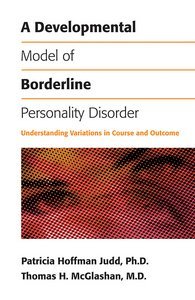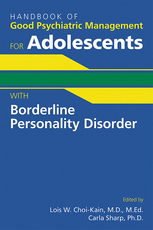A Developmental Model of Borderline Personality Disorder
Understanding Variations in Course and Outcome
View Pricing
Description
Patients with borderline personality disorder (BPD) are among the most challenging patients for clinicians to treat. Their behaviors and emotions can shift abruptly. As a result, these patients can seem like therapeutic moving targets, and improvement can be vexingly slow.
A Developmental Model of Borderline Personality Disorder is a landmark work on this difficult condition. The book emphasizes a developmental approach to BPD based on an in-depth study of inpatients at Chestnut Lodge in Rockville, Maryland, during the years 1950 through 1975 and the authors' thirty years of clinical and supervisory experience. Using information gleaned from the original clinical notes and follow-up studies, the authors present four intriguing case studies to chart the etiology, long-term course, and clinical manifestations of BPD. With three main parts that cover theory, case examples, and practical strategies for treatment, A Developmental Model of Borderline Personality Disorder
- Introduces the reader to a multidimensional and integrated etiologic model of BPD to inform treatment
- Helps clinicians develop the understanding and empathy needed to deal with difficult patient behaviors
- Gives strategies for designing psychotherapy in tandem with psychosocial services to help patients with BPD improve or sustain functioning in the community
A Developmental Model of Borderline Personality Disorder combines rich clinical case descriptions with an integrated theoretical model that captures the complexities of BPD. The first resource to chart BPD over the long term in such depth, this book is a first-rate clinical resource that reads like a novel, illuminating the disorder to help interpret its causes and course. It will inspire and encourage clinicians, along with patients and their family members, to strive for success in treating this difficult disease.
Contents
- Introduction
- Acknowledgments
- Part I: Etiology
- Chapter 1. An Integrated Developmental Model
- Part II: Variations in Course and Outcome: Case Histories
- Chapter 2. The Chestnut Lodge Follow-Up Study
- Chapter 3. When She Was Good...Lillian
- Chapter 4. Love Having No Geography...Susan
- Chapter 5. Kindness of Strangers...Sylvia
- Chapter 6. Wild at Heart...Wendy
- Part III: Treatment
- Chapter 7. Universal Features of Treatment
- Chapter 8. Recurrent Themes and Issues
- Index
About the Authors
Patricia Hoffman Judd, Ph.D., is Clinical Professor of Psychiatry at the University of California, San Diego, School of Medicine, and Program Director of UCSD Outpatient Psychiatric Services in San Diego, California.
Thomas H. McGlashan, M.D., is Professor of Psychiatry at the Yale University School of Medicine and Yale Psychiatric Institute in New Haven, Connecticut.
Related Products
Carousel Control - items will scroll by tabbing through them, otherwise arrows can be used to scroll one item at a time








